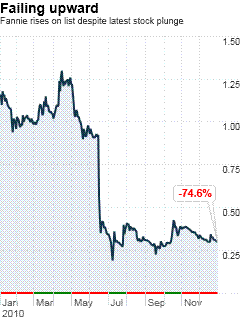房利美如何跻身五强

|
它就是美国政府接管的抵押贷款公司房利美(Fannie Mae),其三年前的濒临破产堪称全美金融灾难演变过程中的一个里程碑。 关于房利美及其小兄弟房地美(Freddie Mac)如何在陷于困境的美国抵押贷款市场中成为第一放款人和最后放款人,已有诸多著述。如今美国每10笔贷款中就有超过9笔是由“两房”或美国政府国民抵押贷款协会(Ginnie Mae)等联邦兄弟机构提供融资或担保,这样的安排上至蒂姆•盖特纳,下至普通投资者都认为缺乏可持续性。 但这并不是推动房利美从去年的《财富》美国500强第81位跃升至今年第5的原因。如今,房利美在榜单上仅次于沃尔玛(Wal-Mart)、埃克森美孚(Exxon)、康菲石油(Conoco)和雪佛龙(Chevron)。 推动房利美排名大幅提升的(房地美亦然,升至第20)是一项旨在防止大金融公司通过表外项目隐藏风险的会计调整。加上《财富》长期以来采用总营收(而非华尔街关注的净营收)排名的政策,这两家“大到不能倒”的公司看起来前所未有的大,如果不是前所未有的好的话。 以房利美为例,两项会计规定——旨在让公司列明所控制资产和随之产生的负债的ASC 860,以及要求金融公司将表外项目移入表内的ASC 810——导致总营收从去年的290亿美元飙升至1,540亿美元。 该数字增长超过四倍,是因为房利美确认了过去所有表外抵押贷款的收益。这令房利美一举超越福特(Ford)、惠普(Hewlett-Packard)等状况良好的大工业公司——虽然房利美亏损140亿美元,美联邦救助成本已达到910亿美元。 但该公司确认的抵押贷款收益增加是虚的——被利息费用所抵消,特别是定期向投资者支付的信托管理成本。 因此,房利美的净营收——投资者常常跟踪的数据,如果现在他们还关注这家境遇糟糕的公司——事实上较上年下降22%至175亿美元。 这样的来回比较可以让你理解为何房利美向美国证券交易委员会(Securities and Exchange Commission)提交的财务报告甚至都不提总营收数据。以净营收计,房利美今年的排名可能低至第94。 但鉴于美国国家财政状况糟糕以及房利美对此负有不可推卸的责任,可能现在是时候让这家差一点破产的机构“安息”了。 |
The company is Fannie Mae (FNMA), the government-controlled mortgage investor whose collapse three years ago was a major milestone along the road to national financial ruin. Much has been made of how Fannie and its little brother Freddie Mac (FMCC) have become the lenders of first and last resort in the troubled U.S. mortgage market. More than nine in 10 loans made nowadays are either financed or guaranteed by the companies or federal cousins such as Ginnie Mae, in an arrangement that everyone from Tim Geithner on down deems unsustainable. But that isn't how Fannie ended up rising to 5 on the Fortune 500, behind only Wal-Mart (WMT), Exxon (XOM), Conoco (COP) and Chevron (CVX), and up from 81st last year. The driver of Fannie's big move up the charts (and Freddie's too, to No. 20) is an accounting change that aims to keep big financial companies from hiding risks by keeping them off the balance sheet. Combine this with Fortune's longstanding policy of calculating its list using gross revenues -- rather than the net revenues that Wall Street tracks -- and you have two too-big-to-fail outfits looking bigger, if not better, than ever. In Fannie's case, the two accounting rules – ASC 860, which aims to make companies list the assets they control and the liabilities they incur, and ASC 810, which calls for financial companies to put off-balance sheet entities back on balance sheet – had the effect of sending gross revenue soaring to $154 billion from $29 billion a year earlier. That number more than quintupled because Fannie got to recognize the income from all the mortgages that it previously held off balance sheet. The rise vaulted Fannie past giant, reasonably healthy industrial companies such as Ford (F) and Hewlett-Packard (HPQ) -- even as Fannie lost $14 billion and the tab on its federal bailout ran to $91 billion. But the income gains the company recognized from the mortgages were illusory -- offset by interest expense, notably the cost of administering the trusts, which make regular payments to investors. As a result, the company's net revenue -- the number investors tend to track, to the extent they bother looking at this sorry outfit anymore -- actually fell 22% from a year ago, to $17.5 billion. This back and forth gives you some idea why the financial reports Fannie publishes with the Securities and Exchange Commission don't even mention the gross revenue number. Using net revenue, Fannie would have ranked a lowly No. 94 this year. But given the pathetic state of our national finances and Fannie's not insubstantial role in the same, maybe it's about time we gave this all-but bankrupt institution its due. |













